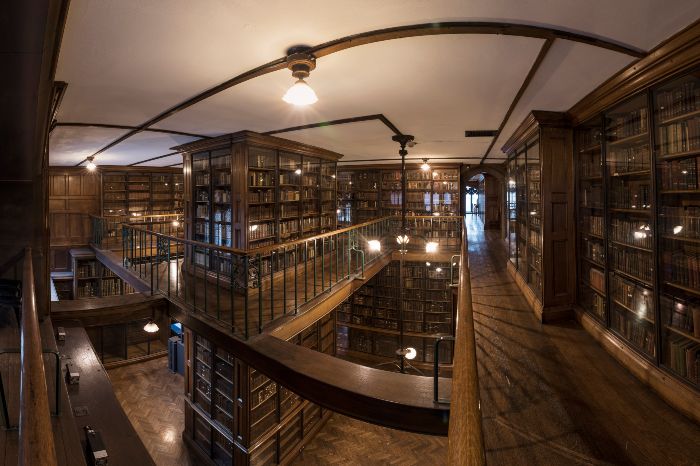Enriqueta Rylands, lover of literature and pioneer of accessible culture, was instrumental in the foundation and legacy of one of Manchester’s most iconic institutions. Here we find out more about the female philanthropist who broke boundaries without ever taking the spotlight.
The John Rylands Research Institute and Library is at the heart of Manchester’s academic and cultural identity. Established in 1900 and merged with our university library in 1972, the Rylands celebrates its 125th anniversary in 2025.
While named after textile entrepreneur John Rylands, the library was founded by Enriqueta Augustina Rylands (née Tennant), a private yet visionary philanthropist who devoted her life to enriching those of the people of Manchester.
Early influences
Enriqueta was born in Cuba in 1843 to a commercial and culturally literate family. Her father was a merchant from Liverpool and her mother a French American, from an entrepreneurial family. Both had ties to celebrated musicians and poets. Enriqueta was baptised as Augustina, to honour Saint Augustine of Canterbury or Saint Augustine of Hippo, a popular saint in Cuba. Prophetically, her namesakes also founded culturally significant libraries in England and Rome.
Uplifting Manchester's cultural standing
After her parents died, Enriqueta – aged just 12 – and her siblings were sent to live with their paternal family in Britain. Despite hailing from a privileged background and receiving a cosmopolitan upbringing, she arrived in Britain as an orphan, and a lack of personal wealth placed her in a socially ambiguous position. It is not known whether Enriqueta sought marriage when she arrived in Britain but she found work as a companion to Martha Rylands, the second wife of entrepreneur and philanthropist, John Rylands. Martha died in 1875 and eight months later Enriqueta, aged 32, married John, aged 74.
John and Enriqueta Rylands both had a passion for books and the pair were united by a desire to uplift the cultural and literary lives of Manchester’s population. When John Rylands died in 1888, leaving his £2.5 million estate (equivalent to £277 million today) to Enriqueta, she began the lifelong project that would come to define her: the foundation of the John Rylands Library.
She also supported various women’s movements, advocating for women’s right to work and recognition of their societal contributions.
Creating an iconic literary institution
Enriqueta commissioned architect Basil Champneys to design the building – a striking architectural hybrid of church and library, inspired by the antiquity of the University of Oxford’s college libraries. She chose the neo-gothic style to imbue the Rylands with the same tradition and heritage as other famed institutions. Enriqueta played an active role in overseeing the design and construction, and her personal touch is evident in the stained-glass windows which celebrate cultural and religious luminaries and feature depictions of Augustine of Hippo.
A year after her husband’s death, Enriqueta began acquiring the books to fill her library. She was personally responsible for purchasing the library’s foundational collections, totalling around 40,000 volumes. In 1892, she bought a collection assembled by John Spencer, the 5th Earl Spencer, which was of great importance to the history of printing in Europe. In 1901, she bought the manuscript collection assembled by the 25th and 26th Earls of Crawford, Alexander and Ludovic Lindsay, spanning 5,000 years and more than 50 languages. Beyond the enrichment of local cultural life, these acquisitions elevated the Rylands to an academic institution of international significance.

The neo-gothic interior of the John Rylands Research Institute and Library
Making culture more accessible
It should be acknowledged that both John and Enriqueta Rylands had links to the slave trade. Rylands’ wealth came from cotton manufacturing, with much of the crop cultivated in the Americas by enslaved men and women. Enriqueta’s father, meanwhile, traded in goods produced by enslaved people – sugar, tobacco and timber, in addition to cotton. Like many buildings of its age, the Rylands Library is inextricably linked to wealth generated by the brutal lives and work of the enslaved.
From its inception, the Rylands was committed to making collections accessible to more than just the academic elite. When its doors opened in 1900, the library hosted public exhibitions and lectures (beginning in 1903), with the aim of democratising knowledge and learning. Thanks to ongoing work carried out by curator Elizabeth Gow, we know that the library had 27,000 visitors in its first year. A diverse group of readers registered early on, including Arthur Guy, an electrical engineer writing a ‘new work on electricity’, and Caroline Herford, a teacher seeking books ‘not otherwise accessible’.
Beyond the Rylands, Enriqueta was involved in other philanthropic work. She donated generously to institutions including the Manchester Wood Street Mission and our forerunners, Owens College and the Victoria University. She also supported various women’s movements, advocating for women’s right to work and recognition of their societal contributions. In 1899, Enriqueta became the first woman to be presented the Freedom of the City of Manchester, an unprecedented honour that illustrated the broader potential of female philanthropy in Victorian Britain.
By dedicating the Rylands to her husband and shrouding herself in anonymity, Enriqueta gained the independence required to exert authority over her work – and her image.
Finding power in anonymity
A lot of Enriqueta’s charitable work remains obscured from public record. She often donated anonymously and disguised herself to make contributions to organisations close to her heart.
While she asked her executors and companions to destroy certain personal papers upon her death, she requested they preserve everything that concerned the Rylands.
By dedicating the Rylands to her husband and shrouding herself in anonymity, Enriqueta gained the independence required to exert authority over her work – and her image. Many histories of the Rylands ignore Enriqueta or reduce her role to that of financial benefactor. While this appears unjust, the philanthropist herself might be satisfied that her legacy is not defined by her personal life, but by the extraordinary gift she bestowed upon the city of Manchester.
Today, the John Rylands Research Institute and Library remains an essential part of the University’s academic and cultural landscape. With its world-class collections and architectural splendour, it continues to inspire students, scholars, and visitors – fulfilling Enriqueta’s enduring vision of knowledge, access, and learning.
Learn more about the work of the John Rylands Research Institute and Library.



.jpg)
.jpg)
